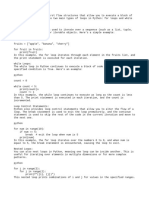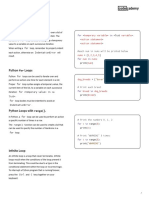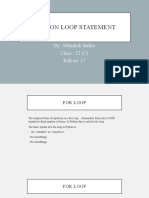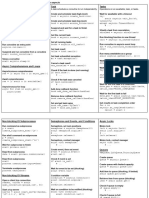0% found this document useful (0 votes)
98 views7 pagesFor Loop & Nested Loops
For loops in Python allow you to iterate over a sequence like a list or range of numbers. A for loop takes the form:
for element in iterable:
# code block
Nested loops involve placing one loop inside another. An outer loop iterates over rows, while an inner loop handles columns. This allows processing of tables with multiple iterations. For example, to print a multiplication table, the outer loop could iterate over numbers 1 to 10 for the rows. The inner loop would then iterate 1 to 4 times to print the columns for each row. Nested loops are useful when complex iterations over multidimensional datasets are required.
Uploaded by
muhammadtalhabilal6666Copyright
© © All Rights Reserved
We take content rights seriously. If you suspect this is your content, claim it here.
Available Formats
Download as DOCX, PDF, TXT or read online on Scribd
0% found this document useful (0 votes)
98 views7 pagesFor Loop & Nested Loops
For loops in Python allow you to iterate over a sequence like a list or range of numbers. A for loop takes the form:
for element in iterable:
# code block
Nested loops involve placing one loop inside another. An outer loop iterates over rows, while an inner loop handles columns. This allows processing of tables with multiple iterations. For example, to print a multiplication table, the outer loop could iterate over numbers 1 to 10 for the rows. The inner loop would then iterate 1 to 4 times to print the columns for each row. Nested loops are useful when complex iterations over multidimensional datasets are required.
Uploaded by
muhammadtalhabilal6666Copyright
© © All Rights Reserved
We take content rights seriously. If you suspect this is your content, claim it here.
Available Formats
Download as DOCX, PDF, TXT or read online on Scribd
/ 7




























































































